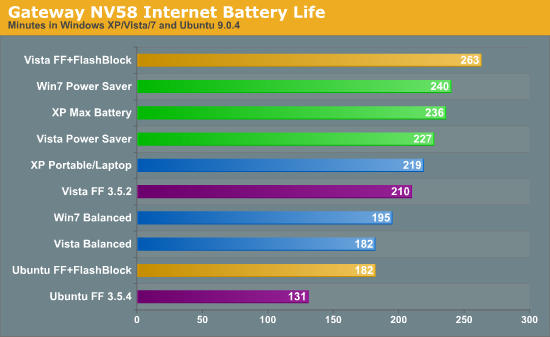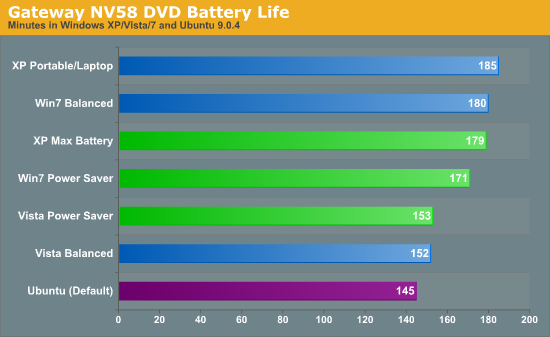Gateway NV58 (Intel) - Battery Life
We first looked at AMD's mobile platform with several operating systems and now it's Intel's turn. Once again, here's the rundown of specifications followed by the results, starting with battery life.
| Gateway NV5807u Test System | |
| Processor | Intel Core 2 Duo T6500 (Dual-core, 2.1GHz, 2MB shared L2, 45nm, 35W, 800MHz FSB) |
| Memory | 2x2048MB Micron PC2-5300 @ DDR2-667 5-5-5-15 (Micron Technologies 16HTF25664HY-667G1) |
| Graphics | Integrated Intel GMA 4500MHD Driver version 15.13.4.64.1829 10 Shaders at 475 MHz |
| Display | 15.6" Glossy WXGA (1366x768) LG LP156WH2-TLE1 |
| Hard Drive | HITACHI Travelstar 5K500.B 320GB 5400RPM 8MB (HTS545032B9A300) |
| Optical Drive | 8x DVDRW (TSST Corp TS-L633B) |
| Battery | 6-Cell 10.8V, 4400mAhr, 47.5Whr |
| Operating System | Windows Vista Home Premium 64-bit |
| Price | NV5814u available online starting at $580 |


If you expected the standings to remain the same regardless of computer hardware, you might be in for a bit of a surprise by the above charts. This time, Windows XP wins in both DVD playback results, providing better battery life using the "Portable" profile than the "Max Battery" profile. Windows 7 also performs slightly better on DVD playback using the Balanced profile, whereas we saw virtually no difference between the power profiles using the NV52.
Why is Balanced beating Power Saver this time? Intel's SpeedStep technology appears to be better than AMD's PowerNow!, though minor differences in drivers may also contribute to the standings. The theory is that letting your CPU run at 100% for a short time and then returning to minimum power draw as fast as possible results in the best battery life, which is why setting the maximum CPU state to 50% isn't always the best idea. Intel CPUs are supposed to switch between C-states faster than AMD CPUs, or so we've heard, and these results seem to support that idea. However, the Internet battery tests again all favor the power saving profiles by a large margin, so power saving profiles can have a positive impact, just not in DVD playback. Ubuntu brings up the rear in both battery life tests once again.
Internet battery life shows different standings on the three Windows operating systems compared to the NV52. Windows 7 is just 2% ahead of XP and 6% ahead of Vista with the power saving profile; switch to the balanced profile and XP jumps into the lead offering 12% more battery life than Windows 7 and 20% more battery life than Vista. Looking at the profiles, Windows XP shows the smallest change by using a power saving profile, improving by 8% when using the Max Battery option. Windows 7 and Vista both improve by around 25% (23% for Windows 7). That means all three Windows OSes did better in Internet battery life with power saving profiles relative to the NV52.
Our testing with Ubuntu once again requires a bit of explanation. First, LCD brightness adjustment did not work properly under Ubuntu (with the drivers we used), with the final setting ending up at 150 nits instead of 100 nits. That means battery life is going to be slightly lower because the LCD is consuming an extra 1-2W. Second, unlike the NV52, we didn't experience any difficulties with DVD playback - hooray! Internet performance using Firefox still feels horribly slow in comparison to Firefox or Internet Explorer on Windows, and while blocking Flash content helps we still prefer Windows.
Enabling FlashBlock with Firefox again has a substantial impact on battery life; Vista improves by 25% - the same as on the NV52 - and Ubuntu improves by 39% - slightly less of an improvement compared to the NV52. The gap between Vista and Ubuntu is still huge, even bigger than on the NV52. Without FlashBlock, Firefox on Vista offers 60% more battery life than Firefox on Ubuntu. Even with FlashBlock, the gap remains at 45%, which is far more than the Power Saver profile offers.
Overall, Windows XP leads in best-case battery life for DVD playback on the Intel platform, providing 3% more battery life than Windows 7 - not a huge difference. The gap between Windows 7 and Vista is much larger, with the best-case Windows 7 result being 18% higher than the Windows Vista scores. Ubuntu almost matches Windows Vista, and it might even match Vista if we could modify the LCD brightness.










106 Comments
View All Comments
Veerappan - Tuesday, September 22, 2009 - link
I'm not sure if it's possible at this point, but if you can, would it be possible to try out a copy of the 9.10 Alphas that are available? They should hopefully fix some of the intel driver regressions.Also, as an FYI/diagnostic, there's a CPU speed applet that is available in Gnome. Right click the top panel, select 'add to panel', and then somewhere there's a cpu speed monitor. That can be used to see if SpeedStep/Cool'n'Quiet are working correctly. You can even take it a step further, and change the permissions of the applet to allow you to change which CPU speed governor is active if you find that the CPU is running at full speed constantly.
lyeoh - Tuesday, September 22, 2009 - link
By the way, you should not use external sites during your test. The fact that you said "perhaps a Flash ad server was temporarily down" means you are doing it wrong.Different flash ads could be very different in CPU usage.
What you should do is snapshot/save the complete pages loaded from the websites you want, put them on a standardized webserver under your control, and then get the browsers to load the pages from that webserver. Disconnect the test network from the internet to prove that the page loads up fine without requiring external connections (css etc). You may need to include a test DNS server that fakes the replies, or stick to using IP addresses to access the test pages e.g. http://10.5.5.1/site1/testpage1.html">http://10.5.5.1/site1/testpage1.html http://10.5.5.1/site2/testpage1.html">http://10.5.5.1/site2/testpage1.html http://10.5.5.1/site3/testpage1.html">http://10.5.5.1/site3/testpage1.html
Once you have standardized on a set of pages, this means you don't have to redo the tests on all computers weeks/months later when you have another laptop to test. You only need to test the new device - since the pages are the same. Don't change the webserver too much either (but given the low loads it's unlikely to affect things much - unless it's really really slow).
JarredWalton - Tuesday, September 22, 2009 - link
Already in progress, after my round two Internet testing still proved too variable. As noted elsewhere, though, I want the content to be as close to realistic as possible. Law of averages says that most of the ads will balance out. It's also possible my home wireless phone knocked out my home WiFi a few times, which would mean several minutes (more?) of non-traffic. Many times I'm not around while letting the battery drain, since that's a bit of a waste of time.I need a new home phone for sure, though. The 2.4GHz model I bought several years back wreaks havoc on my 802.11n network.
strikeback03 - Wednesday, September 23, 2009 - link
You need a home phone at all?JarredWalton - Wednesday, September 23, 2009 - link
Babysitters might need something to call us, yeah. Could leave a cell with them I suppose, but I also use it for business/fax.7Enigma - Wednesday, September 23, 2009 - link
I highly recommend the Uniden DECT6.0 models. The kit I got about 6 months ago to replace crappy old units was ~$110 for 3 units. Additional units (if your manion requires :) can be added easily to the setup for another $30-40. No wireless issues whatsoever. And it's the first phone I've been able to use out to my curb without issues (brick exterior with plaster walls = bad signal). The only gripe I have is there doesn't appear to be a way to change the caller ID name when it comes in. You can program your own numbers in, but when you receive a call it always shows only how caller ID recognizes it.Got mine from the egg.
mschira - Monday, September 21, 2009 - link
on my Atom based laptop. Flash is mostly used for annoying advertising. And it eats CPU, makes the budy slow.Booo to flash...
M.
dnd728 - Tuesday, September 22, 2009 - link
If Adobe merely added a button to freeze all Flash animations or even just freeze all Flash in non-active tabs, then like a hundred power plants could have been scraped…JarredWalton - Tuesday, September 22, 2009 - link
Which is what FlashBlock does. :) Of course, Linux browsers by default don't normally auto-play Flash I don't think. I enabled that with Firefox and then used FlashBlock to stop it, just for an "apples-to-unoptimized-apples" comparison to Vista.bigboxes - Monday, September 21, 2009 - link
Whatever. I use adblock plus and see few ads. Flash, however, is a part of how we view the internet. It's a part of our experience. If you want a text only internet please feel free to step back in the wayback machine to 1988.